
When your content strategy is planned out on one calendar, it’s easier to keep organized, focus on deadlines, and be more productive. Your content calendar keeps your entire team updated with the latest and upcoming projects.
Just picture this:
- You have a versatile content calendar to help you organize your campaigns, track your projects, and easily collaborate with your team.
- You’re provided with an easy-to-follow process for managing said calendar.
- You have several examples of what a great content calendar looks like.
In this post, you’ll learn how to build the perfect content calendar, keep it full of ideas, and make it easier for your marketing team to do their job.
[content_upgrade_shortcode]
[table of contents]
What Is A Content Calendar?
A content calendar is a resource to plan, schedule, and organize content creation and publishing.
Marketing teams rely on their content calendars to plan campaigns across different platforms—like the company’s blog, email marketing, and social networks. It’s their right hand for planning and creating a steady flow of high-quality content.
What Is A Social Media Content Calendar?
Content calendars are designed to organize all content formats, such as blog posts, emails, videos, social media posts, etc. A social media content calendar lists all the social media posts you plan to make and publish in the future. A spreadsheet, Google calendar, or a social media management tool can help you keep track of your activities.
It’s best to think of a social media calendar as a sub-calendar that falls within a content calendar. Again, a content calendar contains all types of content, while a social media calendar only organizes social media campaigns and posts.
The most successful marketers document their entire marketing strategy, not just a single channel like social networks.
What Is An Editorial Calendar?
An editorial calendar, often called a publishing schedule, is an indispensable tool for content creators. This visual workflow is used by bloggers, publishers, businesses, and groups to meticulously organize and schedule their work. It serves as a roadmap for what content should be published, where it should be posted, and the most crucial part, when it should go live. From newspapers and magazines to blogs, email newsletters, and various social media outlets, an editorial calendar streamlines the content creation and publication process. It provides a clear overview of the content strategy, enabling teams to work more efficiently and ensuring that the right content reaches the right audience at the right time.
3 Content Calendar Types
Now you know what a content calendar is, so let’s look at three different ways to plan upcoming content.
1. Content Calendar Software
The best way to manage your content calendar is through marketing calendar software. (No, Google Calendar doesn’t count.)
CoSchedule Marketing Calendar is free and the most powerful content calendar on the market. CoSchedule Marketing Suite builds upon everything in Marketing Calendar with advanced content calendaring, work management, asset management, and content management tools.
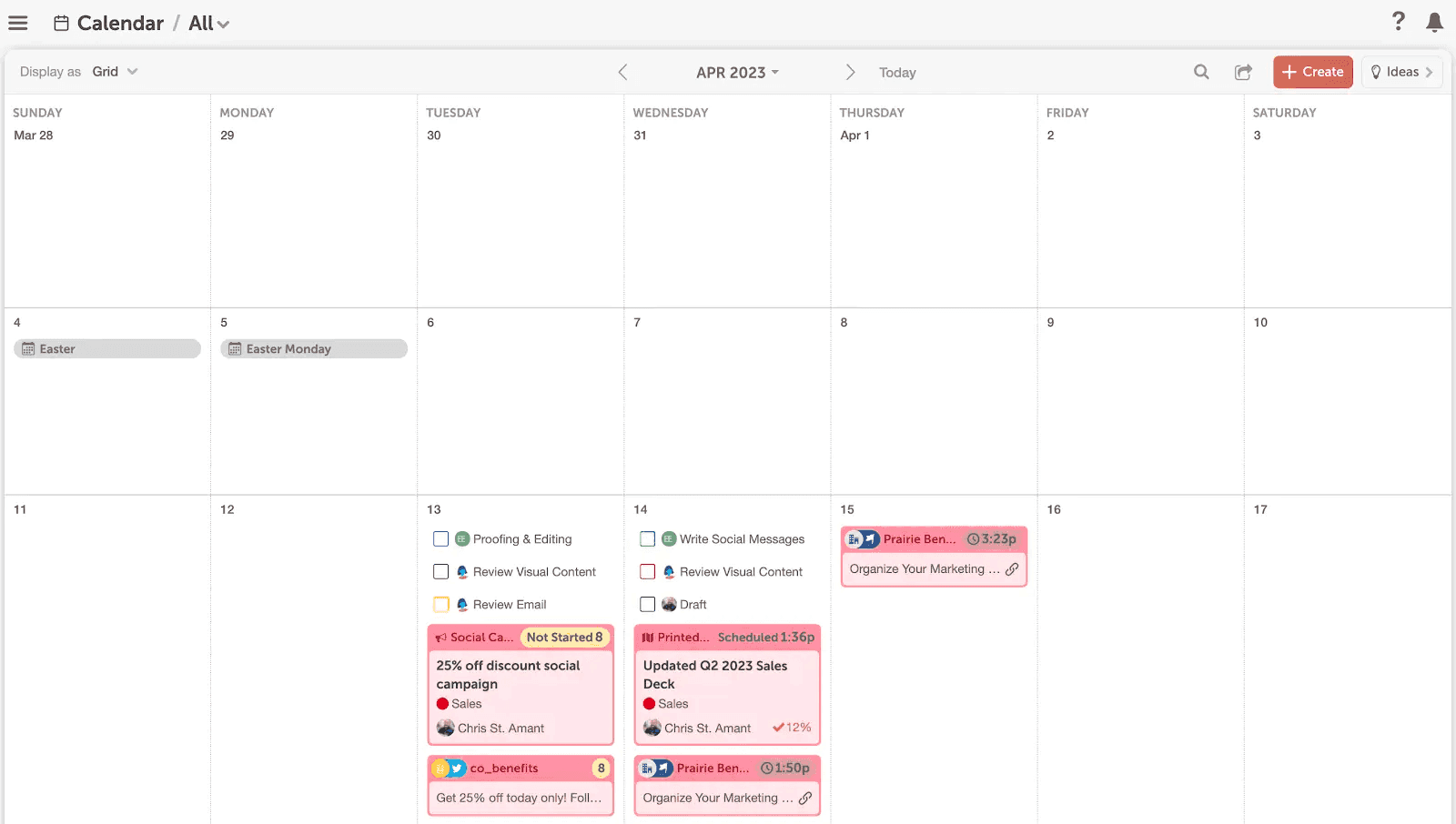
You’ll be able to see important dates on your content calendar (such as product launches) and how that slots within your upcoming content.
Plus, Marketing Calendar integrates with other marketing tools you’re already using, including:
- Your CMS (like WordPress and HubSpot)
- Social media platforms (including Instagram, Facebook, Twitter, LinkedIn, and Pinterest)
- Your email marketing platform (like Mailchimp, ActiveCampaign, Campaign Monitor, Constant Contact, and HubSpot)
This way, you can easily automate the planning and distribution of each new piece of content. Talk about saving time.
2. Content Calendar Kanban Boards
Kanban boards, which look like virtual whiteboards with mini post-its, can also be used to manage a content calendar.
They’re great for visually managing workflows and are especially suited for agile teams. You can use tools like Trello or CoSchedule Marketing Suite Idea Board to create columns for the status of a piece, the platform it’s on, or the week you intend to publish to get an overview of your upcoming content. Just drag and drop the card to the right column.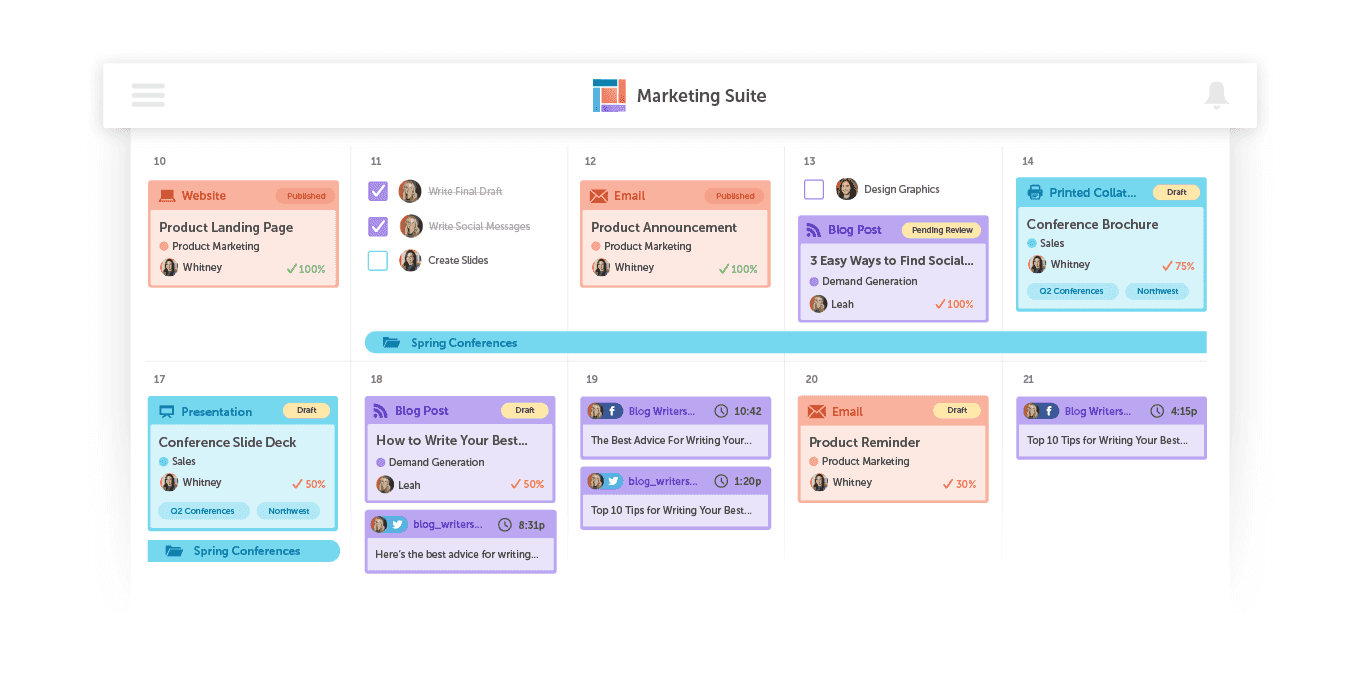 Source
Source
3. Content Calendar Spreadsheets
The simplest way to create a content calendar is to use a spreadsheet.
Tools like Microsoft Excel and Google Sheets make spreadsheets a free and easy way to plan upcoming content. It’ll take a bit of design work, but once you set it up, you’ll see your calendar at a glance and monitor the progress of each piece of content.
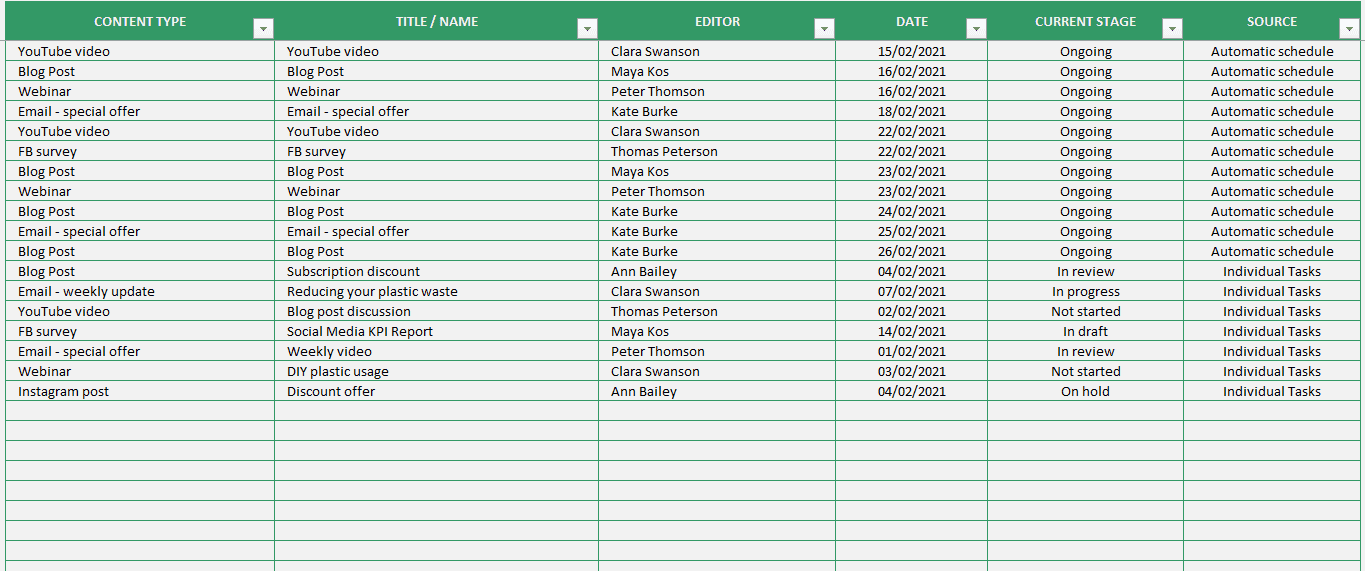
CoSchedule Content Calendar To Organize Your Marketing Plan
What tool is commonly used to create content calendars? With my decades of marketing experience, I typically see marketers begin content calendaring with free tools such as CoSchedule Marketing Calendar, Google Calendar, and Trello.
Of these three options, however, only one platform is designed for marketers to organize all of their content in one place—and that software is CoSchedule Marketing Calendar and its big sister, CoSchedule Marketing Suite.
1. CoSchedule Marketing Calendar Freeware
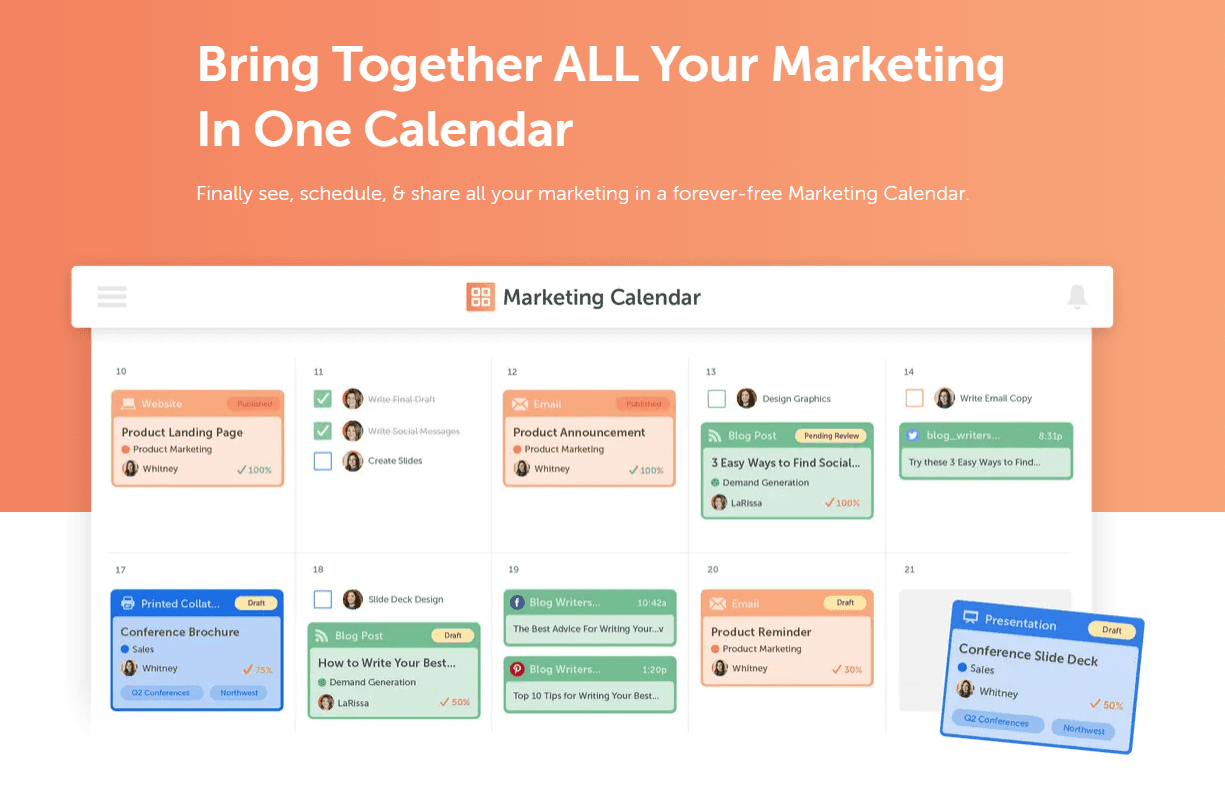
CoSchedule’s free marketing calendar lets you organize marketing content, projects, and social posts all in one place. Attach tasks, files, descriptions, and other organization tools to your calendar items to stay on track.
Our free calendar works great for small-scale marketers who need an easy way to organize their content. Integrations with tools like Google Drive and WordPress let you schedule and publish your work in the same app.
CoSchedule Marketing Suite & Calendar Organizer

Once your marketing operations begin to grow, the CoSchedule Marketing Suite and Calendar Organizer will help you stay on top of them.
The Calendar Organizer adds collaboration features to the free calendar and helps you automate repetitive tasks. Meanwhile, our Marketing Suite offers more ways to coordinate your work, content, and assets.
By itself, the Calendar Organizer costs $29 per month per user. If you’d like to use the Marketing Suite on top of it, we suggest talking with us about your options.
3 Content Calendar Examples From Leading Brands
1. Red Bull
Red Bull is a massive media powerhouse that just happens to sell an energy drink. As you can see from their content calendar, they publish often, including blogs, social media messages, videos, and more.
What conclusions can we draw from Red Bull’s content calendar?
- Post your content where your audience is most active. Red Bull’s audience of 20- to 30-year-old males is most active on Facebook and Instagram. Therefore, it makes sense that Red Bull would publish more content on these channels.
- Reuse video content on social media. Red Bull is known for their incredible video content. Much of that gets shared on Facebook and their other social platforms. You might not be able to shoot the same kind of video, but if you have video content at all, repackage it for social media for maximum mileage.
- Create content that looks and feels authentically like the non-branded content that your audience seeks out. Red Bull is so successful because it looks like content from a publishing house. They don’t feel like they are being sold too.
Takeaway: Organic social media content doesn’t always need to sell directly to succeed.
Content Calendar Cadence:
- Blog Posts: 11-12 pieces per day on redbull.com
- Facebook: 9-11 posts per day
- Instagram: 7-8 posts per day
- Twitter: 1-2 tweets per day
- LinkedIn: Less than 1 post per week

2. Reverb
Reverb.com is an e-commerce website selling almost any music-related instrument you could think of. They know their audience well and have created a reliable and consistent publishing schedule that’s jam-packed with content about musicians, new and old instruments, and techniques their fans would find interesting.
What conclusions can we draw from Reverb’s content calendar?
- If you publish a lot of content, ensure you do it well. One of the reasons that Reverb.com is so successful with their content is because of their ability to tailor it to their audience. They publish a lot of information, but everything is executed well.
- Establish trust with your audience. They can establish trust with their audience by talking to industry experts, popular musicians, and more. People can drop a lot of money on their sites because they can trust what they find.
- Create content that makes it easy to understand how to use complex products. Reverb does a great job explaining what their product does and how to use it. Their product base can get overwhelming and stressful, so Reverb makes it easy to understand and find the dream product their audience is searching for.
Takeaway: Earn your audience’s trust through the content you create.
- Blog Posts: 2-3 pieces per day on reverb.com
- Facebook: 5 posts per day
- Instagram: 2-3 posts per day
- Twitter: 5 tweets per day highlighting various artists, gear, and instruments
- LinkedIn: 2-3 posts per week
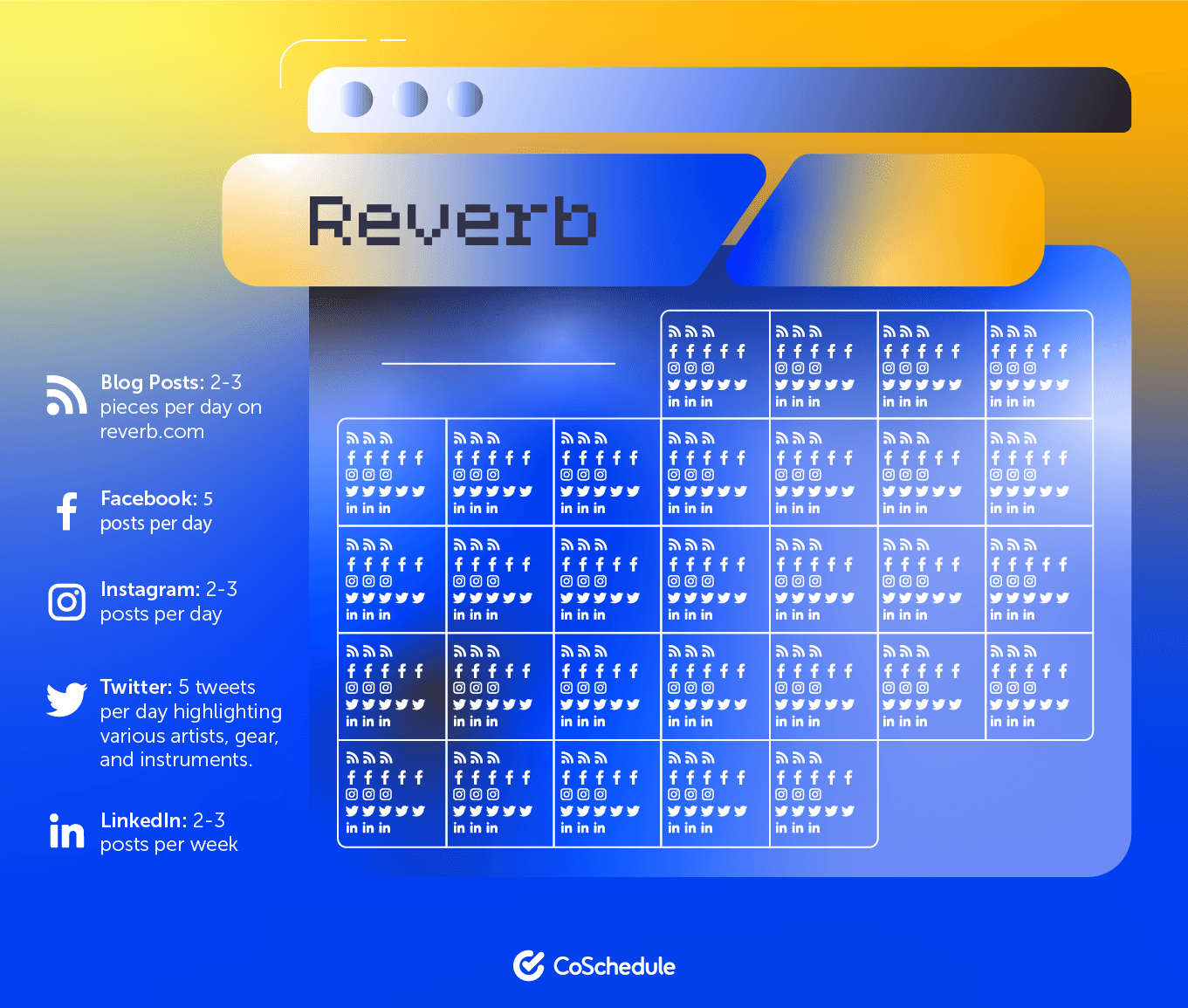
3. Disney Parks
Disney is a behemoth in the hospitality and service world; needless to say, they publish a lot of content. The Disney Parks blog is just one of several blogs, Facebook pages, and more that Disney runs.
What conclusions can we draw from Disney Park’s content calendar?
- Create content that creates FOMO. Disney’s theme parks are full of attractions and fun family things to do. Their content creates FOMO, or the feeling of missing out on all the fun. This move creates urgency and a longing for your audience to take action.
- Show them what they will experience. Create content that shows your audience what they will get or experience when they purchase your products. Instead of letting them guess what will happen, show them instead.
- Help them have the best time when they do business with you. Disney’s content focuses a lot on the experiences that their customers have. You can also let your content show them how working with you creates the best possible experience they’ll ever have.
Takeaway: Show your audience how to create an experience when they visit you.
- Blog Posts: 5 pieces per day on the Disney Parks blog
- Facebook: 1-2 posts per day
- Instagram: 3-4 posts per day
- Twitter: 5 tweets per day sharing news about events and magic-filled photos
- LinkedIn: 7-8 posts per week

How To Create A Content Calendar
How do you structure a content calendar? What should a content calendar include? We hear these questions often. There are a variety of templates available to optimize your content calendar.
Here are five easy steps to creating an effective content calendar.
1. Platform Information
To help you plan your content schedule, list all the channels you want to publish to. Try to match your channel with your target audience. TikTok may help reach a younger audience, but the channel won’t get much traction among B2B buyers.
If you take the time to understand the benefits and shortcomings of each channel, you may avoid spending time and money promoting to people who aren’t interested in your product or service.
While it’s possible to use a single calendar for many platforms, it’s not encouraged. For example, if you plan to post on numerous channels, you may want to create a separate social media content calendar and a blog content calendar.
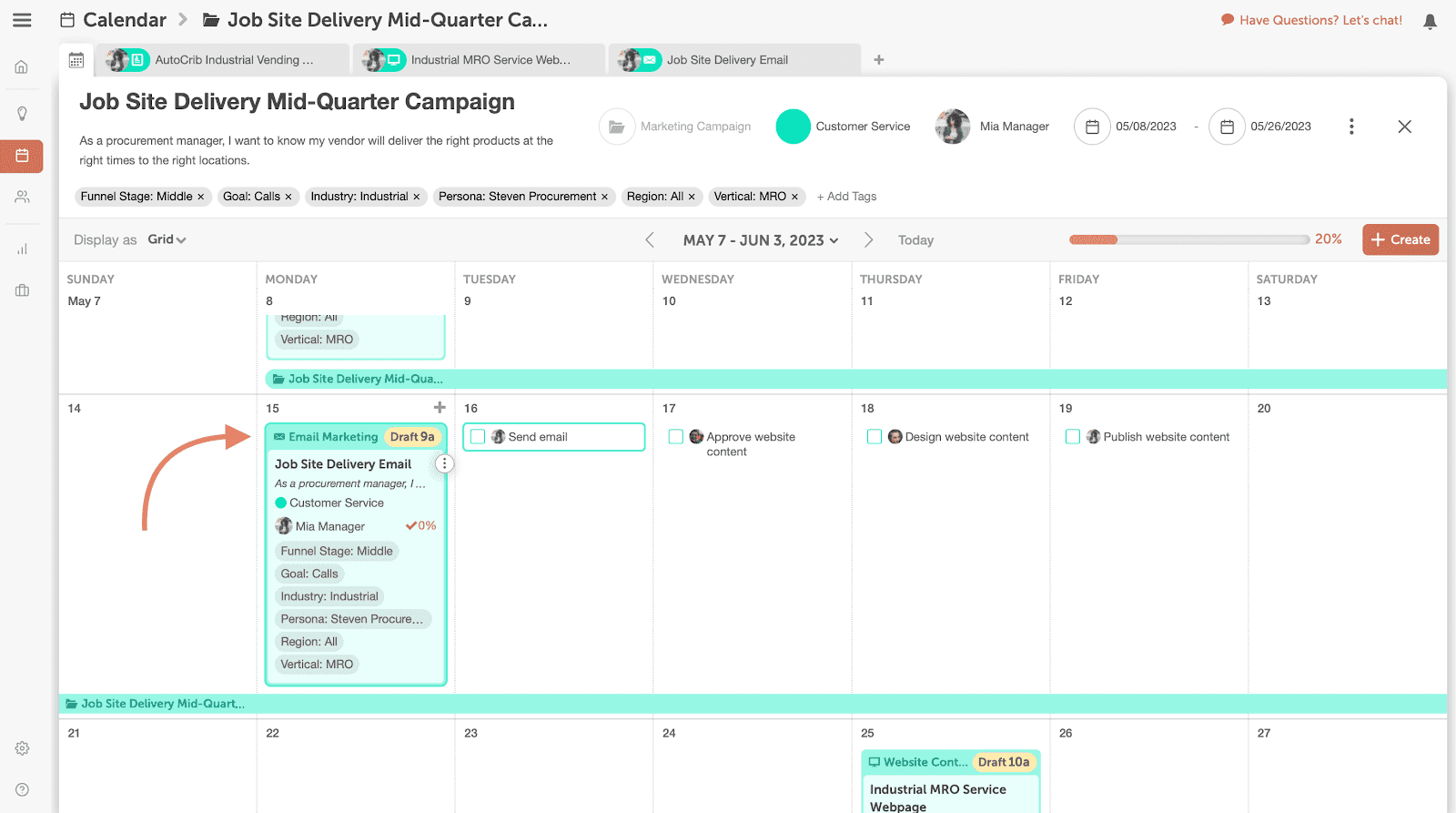
2. Publish Deadlines
A content calendar must include deadlines for all tasks that help you produce content. Deadlines are a tool to control the chaos and guarantee a consistent flow of published content.
When establishing deadlines, be realistic about the time it will take to complete tasks. The date and time of the content’s publication should be made public.
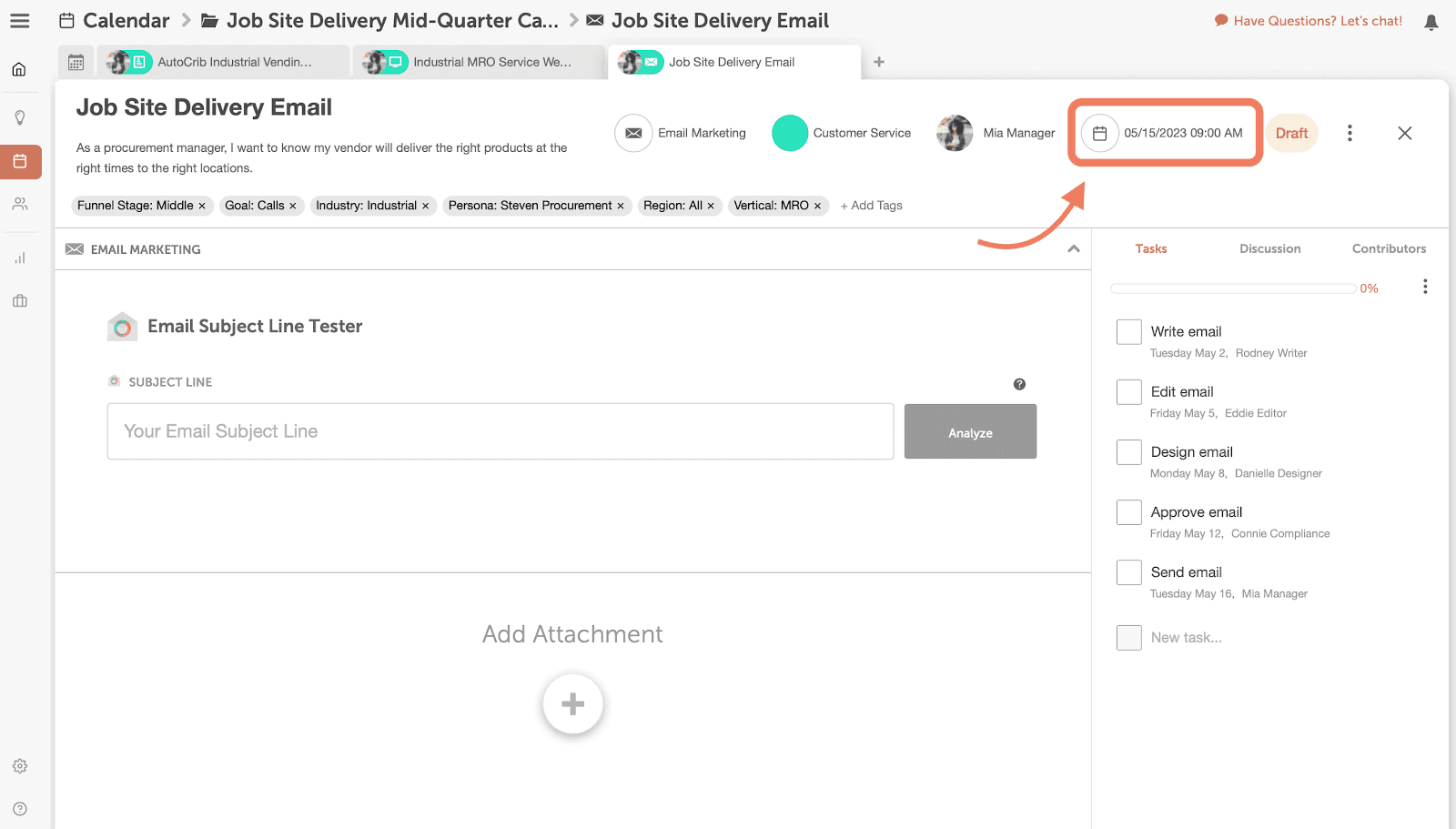
3. Campaign Attribution Information
As a content marketer, you can help with many business goals, including increasing brand recognition, traffic to your website, sales opportunities, converting leads into customers, and improving customer relationships.
Place each content idea on your schedule after mapping it to your sales funnel:
- Top of the funnel (informs the audience)
- Middle of the funnel (offers possible solutions)
- Bottom of the funnel (encourages potential customers to buy your product or service)
Incorporating the campaign type directly on the calendar is wise because various campaigns require distinct content planning. You can use separate tags for outreach to bloggers, SEO campaigns, paid advertisements, and off-site content, among other things.
To avoid any last-minute confusion among marketers or writers, you should also carefully note which target vertical or campaign the content belongs to.
You also must note the broad subject matter or category of your postings in the content calendar. Write down the key points you want to bring up in your content. Focus on topics relevant to your target audience and align with your brand’s message.

4. Asset Links
The content calendar should include links to the content brief, which the writer must follow to adhere to the content guidelines.
Since content briefs are typically extensive, the most effective way to integrate them is to upload the brief somewhere else and then link it to the calendar. For this, you may use Google Docs.
The intended visuals for a post must also link to the content calendar, preferably within the brief itself. Adding the article’s URL to the calendar after the content is published will allow you to discover past posts without searching the archives.
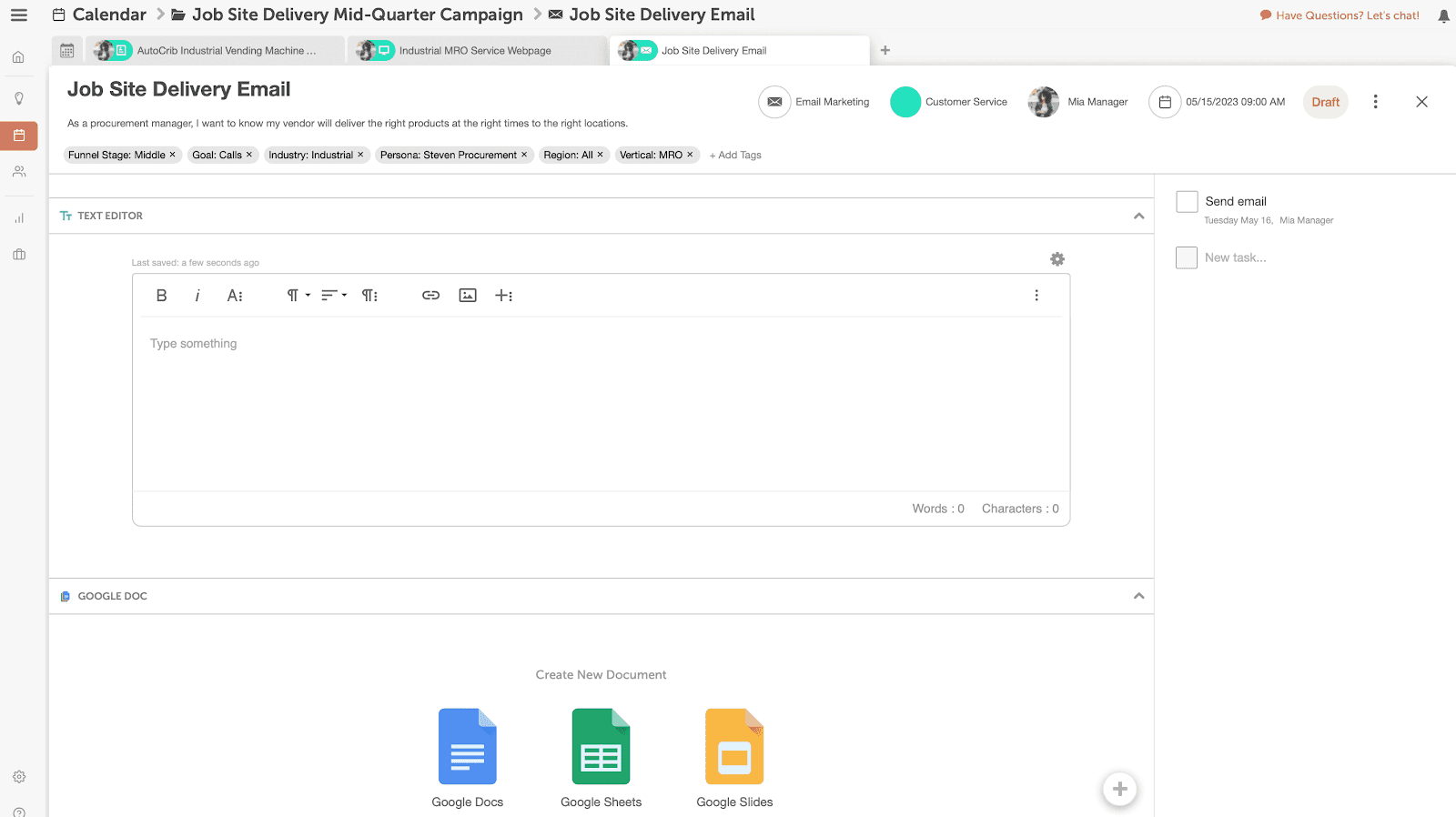
5. Workflow
When defining your content workflows, calendars will have the most significant influence on the production process. Repeatable workflows are the key to having a successful content calendar where each assignee will know beforehand which tasks they must complete. Examples include:
- Task Assignments: Set a deadline for each piece of content and hold each team member responsible.
- Writing: The writers write the first draft.
- Deadlines: The writer must comply with the deadline given in the content calendar.
- Review: Managers, lawyers, compliance officers, product managers, or subject matter experts are among those who may need to review the content.
- Edits: The writer updates based on reviewer input.
- Design: Every piece of content will require some form of design.
- Publication: The content is live!
- Measurement and review: Analyze how well your content is performing in terms of SEO rankings, social media interaction, page visits, and conversions.
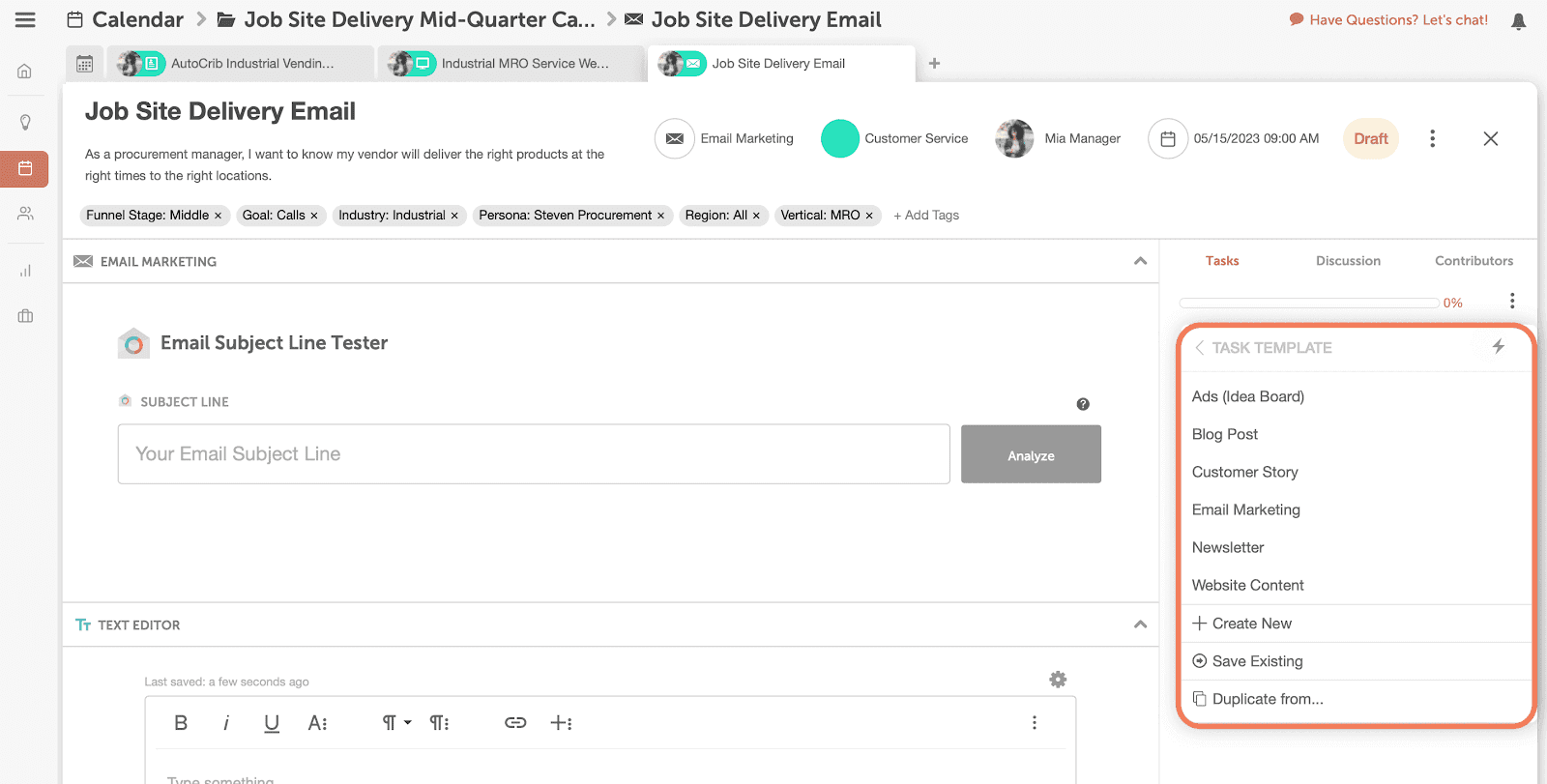
Why Use A Content Calendar?
Why are content calendars important? Here are five good reasons to begin your content calendar as soon as possible.
1. Get Organized & Be More Successful
Marketers who proactively plan their marketing are 331% more successful than their peers. A content calendar is crucial because it will provide you with a better picture of your complete marketing plan. It will help you fix content gaps and prevent missing a deadline.
2. Save Time & Gain Free Time
Planning your content ahead of time can save you plenty of time and effort. You’ll be able to upload and go about your day if you have your content ready every scheduled day. Using a content schedule will also give you time to develop new marketing ideas for content.
3. Reduce Stress & Minimize Mistakes
Planning posts for weeks or months reduces the stress of figuring out what to write on a given day, which is time-consuming and a productivity killer. Making and scheduling posts in advance also decreases the chance of forgetting to post, ensures that your material is released when your audience is engaged, and eliminates the concern of forgetting significant dates.
4. Increase Consistency & Cohesion With Your Marketing Strategy
With a content calendar, you can ensure no days or weeks go by where no new content is shared on your various platforms. Writing a blog article or creating an infographic at the last minute can result in grammatical errors and other issues, ruining your brand’s overall marketing strategy.
A content calendar lets you plan and devote time to consistently creating high-quality content. As a result, your company’s platforms will have a steady stream of activity, which will help create your brand’s voice and keep the audience engaged.
5. Capitalize On Seasonality, Holidays, Events, & Trends
You won’t miss an opportunity to ride the wave of any critical events if you build a content calendar. It is easier to prepare and arrange around significant dates that might affect your content if you plan ahead. For example, holiday shopping content will do well during Christmas or Thanksgiving.
Content Calendar FAQs
How Do I Make A Content Calendar For Beginners?
When you create a new calendar with CoSchedule Marketing Calendar, you may follow this comprehensive guide written specifically for beginners to set up your content calendar exactly how you want it.
How Long Does It Take To Make A Content Calendar?
Creating a content calendar with CoSchedule Marketing Calendar takes less than five minutes. If you need a personalized content calendar, the major work will start before you get to organize it. You’ll need 10 to 15 days to write and publish the pieces for the following calendar month.
How Do I Create A Content Calendar In Google Calendar?
Instead of “meetings,” use the event cards as pieces of content. Color code them by initiative or business unit, and name them according to the piece, such as “Content Calendar Blog Post.” You can also create a new calendar on Google Calendar.
How Do You Prepare Content?
First and foremost, you must have a clear content marketing goal that can be broken down into smaller, more manageable steps leading up to the final goal. Then, you want to conduct research and understand your audience with the help of audience interaction, comments, and guidance from the audience. Educating your audience on their most pressing concerns should be your first objective.
This piece was originally published December 13, 2018. It was updated May 7, 2019; December 2, 2019; March 24, 2021; December 30, 2021; September 2022 and November 2023. Leah Dekrey, Elise Dopson, Nathan Ellering, and Melissa King contributed to this piece.
Comments
Post a Comment